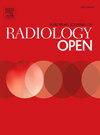前列腺t2加权MRI四种重建技术的比较评价:灵敏度编码、压缩感知、深度学习和超分辨率
IF 2.9
Q3 RADIOLOGY, NUCLEAR MEDICINE & MEDICAL IMAGING
引用次数: 0
摘要
目的采用常规灵敏度编码(SENSE)、压缩感知(CS)、基于模型的深度学习重建(DL)和深度学习超分辨率重建(SR)四种重建方法,对前列腺t2加权成像(T2WI)的图像质量和病变显著性进行评价和比较。方法回顾性研究49例疑似前列腺癌行多参数MRI (mpMRI)或双参数MRI (bpMRI)检查的患者。轴向T2WI采集采用两种协议:传统的SENSE和基于cs的采集。从基于CS的数据中,采用三种重建方法(CS, DL和SR)生成附加图像。两名委员会认证的放射科医生使用4点李克特量表独立评估整体图像质量和清晰度(1 =差,4 =优)。定量分析包括信噪比(SNR)、噪声对比比(CNR)和清晰度指数。对18例经病理证实的前列腺癌患者的PI-RADS T2WI评分及病灶明显程度进行初步评价。采用Wilcoxon符号秩检验进行统计学比较。结果与SENSE、CS和DL相比,ssr在定性(整体图像质量、图像清晰度)和定量(信噪比、CNR、清晰度指数)评估中均获得最高分数(均为成对比较,bonferroni校正p <; 0.0001)。在基于病变的分析中,尽管PI-RADS T2WI评分在重建期间相似,但SR显示病变显著性改善的趋势。结论磁共振重建在定性和定量评价方面均表现出较好的图像质量,在病变可视化方面具有潜在的优势。这些发现虽然基于小样本,但表明SR可能是前列腺MRI的一种有希望的方法,值得在更大的人群中进一步研究。本文章由计算机程序翻译,如有差异,请以英文原文为准。
Comparative evaluation of four reconstruction techniques for prostate T2-weighted MRI: Sensitivity encoding, compressed sensing, deep learning, and super-resolution
Purpose
To evaluate and compare the image quality and lesion conspicuity of prostate T2-weighted imaging (T2WI) using four reconstruction methods: conventional Sensitivity Encoding (SENSE), compressed sensing (CS), model-based deep learning reconstruction (DL), and deep learning super-resolution reconstruction (SR).
Methods
This retrospective study included 49 patients who underwent multiparametric MRI (mpMRI) or biparametric MRI (bpMRI) for suspected prostate cancer. Axial T2WI was acquired using two protocols: conventional SENSE and CS-based acquisition. From the CS-based data, three reconstruction methods (CS, DL, and SR) were applied to generate additional images. Two board-certified radiologists independently assessed overall image quality and sharpness using a 4-point Likert scale (1 = poor, 4 = excellent). Quantitative analysis included signal-to-noise ratio (SNR), contrast-to-noise ratio (CNR), and sharpness index. PI-RADS T2WI scoring and lesion conspicuity were preliminarily evaluated in 18 individuals with pathologically confirmed prostate cancer. Statistical comparisons were conducted using the Wilcoxon signed-rank test.
Results
SR consistently achieved the highest scores in both qualitative (overall image quality, image sharpness) and quantitative (SNR, CNR, sharpness index) assessments, compared with SENSE, CS, and DL (all pairwise comparisons, Bonferroni-corrected p < 0.0001). In lesion-based analysis, SR showed a trend toward improved lesion conspicuity, although PI-RADS T2WI scores were similar across reconstruction.
Conclusion
SR reconstruction demonstrated superior image quality in both qualitative and quantitative assessments and showed potential benefits for lesion visualization. These findings, although based on a small sample, suggest that SR may be a promising approach for prostate MRI and warrants further investigation in larger populations.
求助全文
通过发布文献求助,成功后即可免费获取论文全文。
去求助
来源期刊

European Journal of Radiology Open
Medicine-Radiology, Nuclear Medicine and Imaging
CiteScore
4.10
自引率
5.00%
发文量
55
审稿时长
51 days
 求助内容:
求助内容: 应助结果提醒方式:
应助结果提醒方式:


